#daughter of gustav crown prince of sweden
Explore tagged Tumblr posts
Text

Crown Princess Victoria describes the Danish queen as an "incredibly wise person" with great breadth.
- She is Denmark's queen in the fantastic way she has been over the years, but at the same time, she is also a cultural practitioner in her own right, and I think that has been inspiring and nice to experience.
At the same time, the Swedish heir to the throne admires the queen for the way she has protected the Nordic community and language. The Crown Princess emphasizes, among other things, that the Queen speaks Swedish well.
- It has been incredibly important.
The Norwegian Crown Prince also expresses admiration for the outgoing Danish queen.
- Queen Margrethe has handled her reign in an incredibly good way and in a way that I think Danes really appreciate, says Crown Prince Haakon.
Therefore, there are also big shoes to fill when her son takes over the throne on Sunday.
- It is clear that there is something to live up to, but I am absolutely sure that it will go well.
For Crown Princess Victoria, it is an important person who resigns as regent of Denmark on Sunday.
- She has meant a lot. She absolutely has.
The queen has also been an important figure for the parents of the Swedish heir to the throne.
- I know that for my parents, it has also been incredibly important that you have a close relationship and that there is someone to ask for advice, she says.
Queen Margrethe's mother, Queen Ingrid, was the daughter of the Swedish king Gustav VI Adolf, who is both the grandfather of Queen Margrethe and Sweden's current king, Carl Gustav.
Like Queen Margrethe, Carl Gustav has sat on the throne in Sweden for over 50 years.
Translated excerpt by me from an article by Marie Lagoni Pedersen and Thea Deleuran Müller for DR, published on Jan. 14, 2024, at 06:30.
#danish royal family#queen margrethe ii#crown princess victoria#crown prince haakon#royal reporting#the way they interviewed both Haakon and Victoria but he gets like two sentences while the rest is all about her#justice4haakon
15 notes
·
View notes
Text

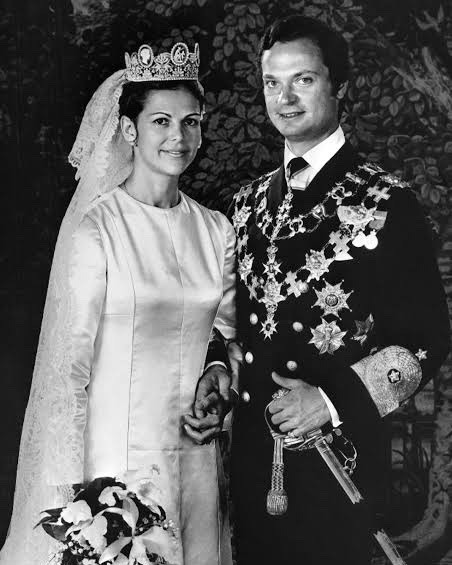
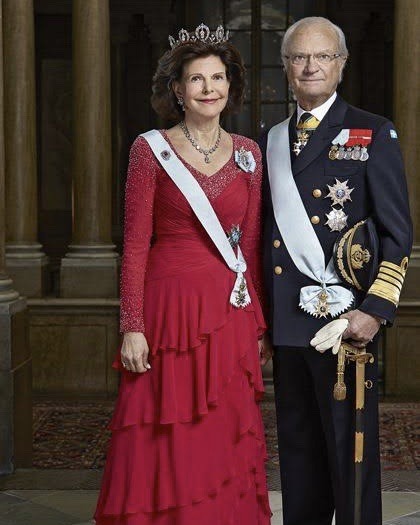
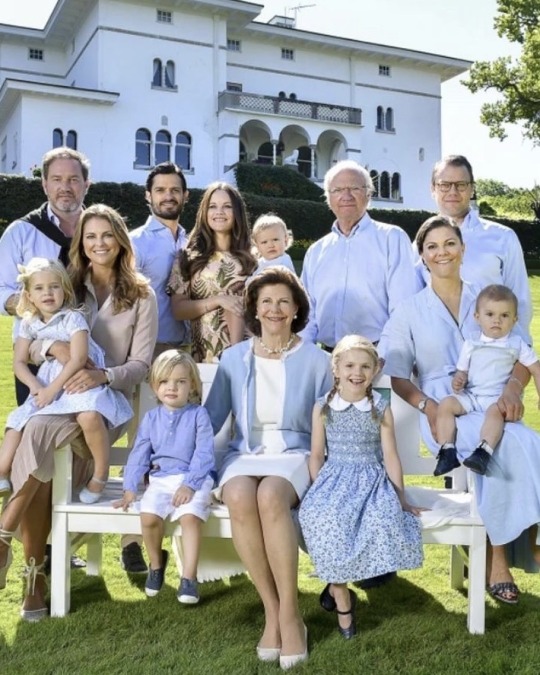
Happy 47th wedding anniversary to King Carl XVI Gustaf and Queen Silvia of Sweden!
The couple tied the knot on June 19 1976 at the Stockholm Cathedral, having met 4 years prior at the 1972 Summer Olympics in Munich; Silvia was assigned to be Carl Gustaf's translator during the games. Carl Gustaf acceded to the throne in the following year following the death of his grandfather.
Their engagement was announced on March 12 1976; the King proposed with a 2-carat ring that belonged to his late mother. Their wedding symbolized the first marriage of a reigning Swedish monarch since King Gustav IV Adolf married Princess Frederica of Baden in 1797; and Silvia became Sweden's first queen consort since 1965.
Their chosen date of June 19 is a symbolic date for the Bernadotte family and one in which multiple family members have gotten married on, including Carl Gustaf and Sofia's eldest daughter, Crown Princess Victoria.
They have three children and eight grandchildren: Crown Princess Victoria, Duchess of Västergötland (45), mother of Princess Estelle (11) and Prince Oscar (7); Prince Carl Philip, Duke of Värmland (44), father of Prince Alexander (7), Prince Gabriel (5) and Prince Julian (2); and Princess Madeleine, Duchess of Hälsingland and Gästrikland, (41), mother of Princess Leonore (9), Prince Nicolas (8) and Princess Adrienne (5).
30 notes
·
View notes
Photo









My 9th annual list of favourite royal moments: 2022 (Part 3/4)
To quote Benoit Blanc: “disruption.” Prince Louis unleashes his adorable brand of chaos and steals the show at the Platinum Jubilee - 4th June
Not many people can say their wedding was a direct middle finger to a dead Nazi but Gustav and Carina can! The couple were finally able to marry after 19 years - 4th June
It was Ingrid’s birthday but I got the gift! For her 18th gala we got multiple teen royals in their first tiara appearances, a photo of the young heirs, and moving and hilarious speeches - 17th June
Soft cupcake Prince Nicolas finally makes an official visit to his Duchy, having a blast on a playground with his mum - 21st June
I got closer to my dream of replacing all royals with dogs when Camilla’s pups posed for Country Life magazine... in pearls! - 10th July
The King of Sweden does a strip tease at his daughter’s birthday, which is not a sentence I ever thought I’d write - 14th July
Spain’s Princess Leonor and Infanta Sofia put every adult royal in Europe to shame as they threw their support behind the Women’s World Cup team, two of the few royals to do so - 16th July
Princess Charlotte experienced a whirlwind of emotions at the Commonwealth Games. She may look just like her father but her facial expressions are all her mother! - 2nd August
Crown Prince Hussein throws one of the biggest curveballs of the year when he announces his engagement to a woman no one even knew existed - 17th August
#favourites#favourite#my upload#prince louis#prince gustav#princess carina#princess ingrid alexandra#prince nicolas#king carl gustaf#king carl xvi gustaf#princess leonor#infanta sofia#princess charlotte#crown prince hussein#british royal family#norwegian royal family#swedish royal family#spanish royal family#jordan royal family
56 notes
·
View notes
Text

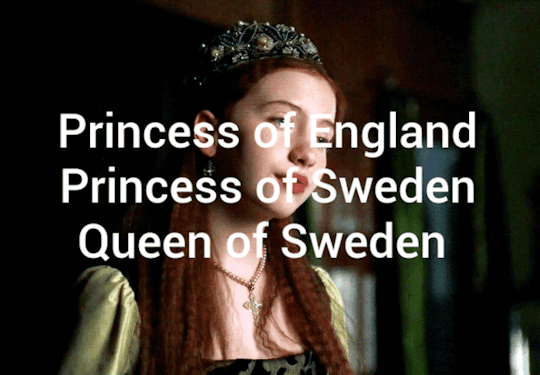

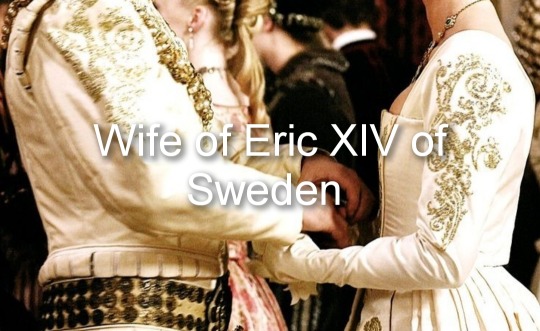
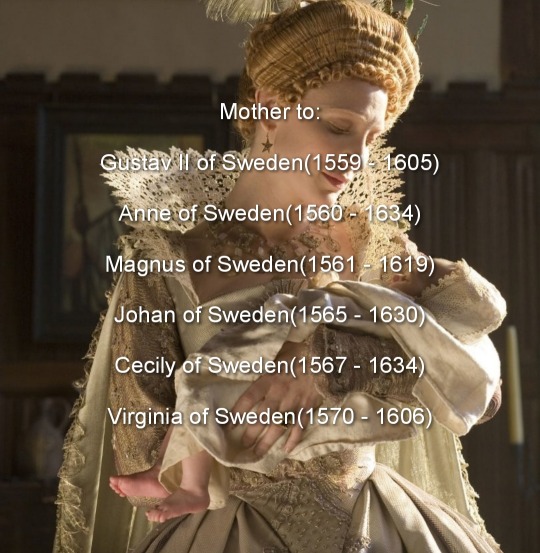
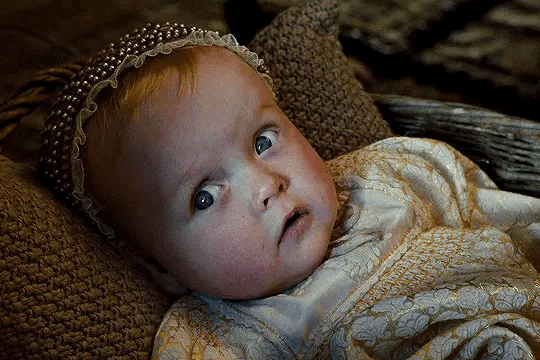
A happier life for Henry VIII's children. Part 2.
Elizabeth was the second daughter of King Henry VIII of England and his second wife Anne Boleyn. When the girl was 3 years old, the king annulled the marriage to her mother. Henry sent Anne to a convent and forbade Anne to communicate with her daughter, and soon afterward married Jane Seymour. She developed a close relationship with her stepmother, brother and sister. In 1547, her father died and Elizabeth was finally able to meet her mother. The meeting between mother and daughter after years of separation was very touching. When Anne saw Elizabeth, she could not believe that this beautiful girl was her daughter. First they cried for a long time in each other's arms, and then they sat up all night talking. They had a lot to say to each other. So their meetings became more and more frequent, and Edward allowed his father's second wife to stay with Elizabeth. In 1557 Edward VI began to look for worthy suitors from Protestant countries, for the hand of his sister, and his choice fell on the eldest son of the King of Sweden, Prince Eric. In the king's opinion, this marriage was to strengthen the sympathy of his subjects for him. In 1558, the princess became the wife of the heir to the Swedish crown, and 2 years later they became King and Queen of Sweden. It is said that at their first meeting the prince was so enchanted by her beauty that he lost the power of speech. Their married life was strong and passionate. For her husband Elizabeth became the most important confidante, with whom he discussed many problems. Six children were born in the marriage:
Gustav II of Sweden (1559 - 1605) Not interested in politics and never wanted to be king. Overthrown and killed by conspirators, including his own son Charles. Husband of Maria of Austria. Father of 4 children: Charles IX, Ludwig, Frederick, Elizabeth.
Anne of Sweden (1560 - 1634) Countess of East Friesland. At the age of 18 she married her cousin Enno III. The marriage was a happy one for both spouses. They became the parents of 9 children: Edzard III, Sabina, Agnes, Johann, Gustav, Rudolf, Christina, Sophia, Christian.
Magnus of Sweden(1561 - 1619) In 1582 he married his cousin Mary of England. They had 4 children: Nils, Katharina, Gunilla, Arnold. Magnus was widowed in 1590. And in 1592 he married his mistress Maria Oberg, but before that he received from his elder brother-king and his mother a permission to remarry. From his second wife he had 6 children: Magdalena, Sven, Hokon, Valdemar, Ingeborga, Svante.
Johan of Sweden(1565 - 1630) From childhood Johan was interested in navigation and discoveries. Therefore, he spent most of his life traveling, exploring lands not previously known. He was never married, however he recognized 3 children: Brita, Lars, Eric. And upon his death, he left each child a generous inheritance.
Cecily of Sweden(1567 - 1634) Macgravine of Baden-Rodemachern. In 1583 became the wife of Edward Fortunatus They became the parents of 5 children: Christoph III, Cecily, Elizabeth, Ottilia, Herman. In 1603, her husband died and Cecily was offered remarriage
Virginia of Sweden(1570 - 1606) Duchess of Holstein-Hottorp, wife of Johann Adolf. Virginia was older than her husband by 5 years, but despite this their marriage was happy. They had 7 children: Frederick III, Elisabeth, Conrad, Dorothea, Gedviga, Albrecht and Augusta. The Duchess died of childbirth fever a week after the birth of the last child. After the death of his wife, Johann lived the remaining 10 years until his death as a widower.
In 1568, the queen returned briefly to England for her mother's funeral. In 1577, King Eric XIV of Sweden died, and Elizabeth mourned her husband's death bitterly. But fortunately for Elizabeth, she had her children and grandchildren by her side, who became the meaning of her life. In addition, the Queen Dowager actively influenced the policies of her eldest son, King Gustav II. Gustav, weak-willed and indecisive, was not interested in ruling the state. In fact, the kingdom was ruled by Elizabeth, which did not please her daughter-in-law. Because of this, the two women often conflicted with each other. In March 1603, the Queen Dowager of Sweden died. She was buried in Uppsala Cathedral next to her husband. And 2 years later Gustav II was overthrown and killed. Her grandson Charles became the next king of Sweden.
Tumblr: History.Period Drama
#history#royal family#royalty#history au#au#royal#the tudors#henryviii#british royal family#anne boleyn#english history#tudors#elizabeth i#marytudor#edwardvi#jane seymour#catherine of aragon#britishmonarchy#royals#english royalty#the other boleyn girl#house of tudor#Tudor time
6 notes
·
View notes
Photo

Carola of Vasa, Queen of Saxony (5 August 1833 - 15 December 1907)
#carola of vasa#karoline frederikke franziska stephanie amalia cecilia#queen of saxony#daughter of gustav crown prince of sweden#wife of albert i of saxony#history#women in history#19th century#20th century#art
30 notes
·
View notes
Text
Heir Apparent, Heir Presumptive, Crown Prince & Other Substantive Titles- a How-To On Royal Inheritance
Inheritance can be hard to understand, especially where titles are concerned, so I’ve decided to make a How-To Guide for the period rpc/writers on how the titles work.

**Please note this focuses on European Monarchies
Definitions:
Heir Apparent: an heir apparent is an heir that cannot be replaced in the line of succession. Historically, they were the eldest son of the Monarch (or whoever they were heir to). In modern day, many countries have changed their laws so that it is simply the eldest child.
Heir Presumptive: an heir that can be replaced- whether a sibling, cousin, or distant family member to the Monarch, an heir presumptive is the presumed heir unless the Monarch has a child (historically an eldest daughter would often be heir presumptive until a son was born, with many European countries switching to Absolute Primogeniture, any eldest child is heir apparent)
Crown Prince/Princess: A title used in many countries for the Heir Apparent of the Monarch. Some countries use other titles (Hereditary Prince, Prince of Wales, Prince of Asturias, etc).and in those instances Crown Prince will be rarely or even never used.
Substantive Title: A title held by nobility or royalty, not a courtesy title. Titles used by heirs to Monarchs (other than crown prince) are substantive titles. In Europe Belgium, The Netherlands, and The United Kingdom have substantive titles reserved for the Heir Apparent. Monaco and Spain have substantive titles that heir presumptive can use.
FAQ:
what is the difference between heir apparent and heir presumptive? an heir apparent will be the next holder of the title (unless they die before the holder of the title), where as an heir presumptive will not always inherit the title. an heir presumptive can be replaced in the line of succession by an heir apparent
has an heir apparent ever lost their position? yes. in 1979 prince carl philip was born, and as a son he was was ahead of his sister victoria in line to the throne, and as heir apparent he was crown prince, as the country had male preference primogeniture. however in 1980 sweden adopted absolute primogeniture, and victoria became crown princess and first in line to the throne. other times heirs apparent have lost their position include james stuart (son of james ii &vii) due to being raised as catholic, crown prince gustav (son of gustav iv) due to his father being disposed,
how can an heir apparent lose their position? like in cases above, if a monarch is overthrown their heirs can also be removed from succession. some countries have stipulations- for example the british heir to the throne would lose their position is they converted to catholicism (and pre-2011 marrying a catholic would also cause them to lose their position), in many countries marrying without the permission of the monarch or parliament could also cause someone to lose their position.
which countries use crown prince as a title? bahrain, brunei, denmark, jordan, kuwait, lesotho, morocco, norway, oman, saudi arabia, sweden, and tonga
what about countries who don’t have a king, but a grand duke or prince? often hereditary prince will be used as a title. crown prince is usually reserved for the heirs of kings. in luxembourg the heir to the grand duke is the hereditary grand duke, and in monaco the heir to the prince is the hereditary prince (the title marquis of baux may be conferred onto the heir apparent or an heir presumptive)
what does it mean to have a titled conferred? the sovereign has to give the title- while a crown prince is born (or automatically inherits) with the title, some substantive titles must be conferred. in britain (and historically england), the heir apparent is conferred the title prince of wales (they automatically hold the title duke of cornwall & duke of rothesy, among others). in monaco the heir (open to both heir apparent and heir presumptive) can be conferred the title marquis of baux or duke of valentinois.
what countries use substantive titles? modern countries: belgium (duke of brabant), monaco (marquis of baux/duke of valentinois), netherlands (prince of orange), spain (prince of asturias), the united kingdom (prince of wales, duke of cornwall, duke of rothesy). historical countries: above, but also france (dauphin), portugal (duke of braganza), england (prince of wales, duke of cornwall), tuscany (grand prince), scotland (duke of rothesy), russia (tsarevich), italy (prince of piedmont, prince of naples), bohemia (margrave of moravia), bulgaria (prince of turnovo), portugual (prince of brazil)
has an heir presumptive ever became monarch? yes. elizabeth ii was heir presumptive (as she was the eldest daughter of a king) as at the time of her succession the uk had male preference primogeniture- if at any point her father had a son, elizabeth would have been displaced. this goes for all monarchs who were women in a kingdom with male preference primogeniture. as well, any time a sibling or cousin came to the throne via the line of succession, they were heir presumptive as their place in the succession would have changed had the monarch had a child.
is an heir presumptive called a crown prince? no, crown princes are heirs apparent.
what is a crown princess? a crown princess is either an heiress apparent, or the wife of a crown prince. Until the 20th century, all crown princesses were wives of crown princes, as male preference primogeniture or salic law was in place.
what is salic law? agnatic primogeniture. bares women from inheritance, all inheritance is via the male line only. france is known for it’s salic law. quasi-salic law allows men from a female line to inherit (ie, the king’s daughter’s son might inherit if the king has no sons).
do heirs presumptive get substantive titles? in spain an heir presumptive may use the title prince of asturias and in monaco a sovereign prince may confer the marquis of baux upon an heir presumptive. in other situations a sovereign or monarch could bestow a title upon an heir presumptive but it is not automatic, and they would usually not be the titles reserved for heirs apparent.
what is absolute primogeniture? absolute primogeniture allows the oldest child of a monarch to inherit, regardless of gender.
what about illegitimate children? illegitimate children are not in the line of succession. some may be given substantive titles and recognized by their royal parent, but they are not eligible to be heir. in some countries, illegitimate children can be styled as royal highness and have the title of prince(ss) but not be in the succession (for example, princess delphine of belgium). some countries will allow a child to be legitimized if the parents marry, and at that point the child is placed in the line of succession- but some countries will not retroactively legitimize a child through a parent’s marriage. in france, a llégitimée de france was a bastard of the king’s that was declared legitimate, and thus had a place at court above the nobility- but not in succession.
70 notes
·
View notes
Photo

Sweden's new king, Gustavus Adolphus, or Gustav Adolf, V, who ascended to the throne on December 8, within a few hours after the death of his father, Oscar II, is believed to entertain ideas of a very different character from those of the late king on the subjects of his country's role in European politics. In the first place, he always disapproved of his father's lenient and kindly attitude towards Norway when that country separated from Sweden. Several days before King Oscar's death, while the present king was Regent, the majority of the cabinet resigned owing to the Regent's refusal to permit Sweden to become a signatory to the treaty insuring the integrity and neutrality of its sister country. This matter is treated at a greater length on another page this month. The late King Oscar's career and his gentle, manly virutes are set forth, also, in the excellent article by Mr. Bjorkman. In matters of foreign policy, King Gustav is believed to lean in the direction of Germany. He has at any rate always cultivated a close intimacy with the Kaiser. Personally he is a man of studious habits, not so democratic as his father and without the latter's peculiar charm of manner. King Gustav was married in 1881 to Princess Victoria, daughter of the Grand Duke of Baden. They have three children: Prince Gustav Adolf, Duke of Scania, who married in June, 1905, the Princess Victoria of Connaught; Prince Wilhelm, and Prince Eric. The present Crown Prince and heir to the throne and Princess Victoria have one child, whose name is also Gustav Adolf, born in April 1906.
The American Review of Reviews, 1908
10 notes
·
View notes
Photo



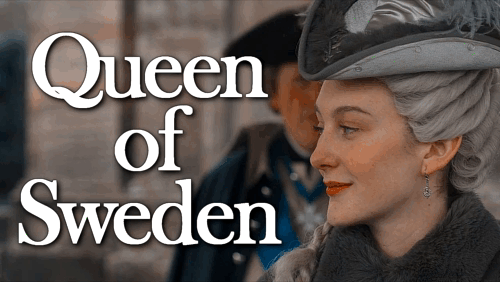






House of Hohenzollern & of Oldenburg: Princess Luise Ulrike of Prussia
Luise was the tenth child and sixth daughter of King Frederick William I of Prussia and his wife Princess Sophia Dorothea of Hanover. She was the sister of Frederick the Great, Margravine Wilhelmine of Brandenburg-Bayreuth, Margravine Friederike Luise of Brandenburg-Ansbach, Margravine Sophia Dorothea of Brandenburg-Schwedt, Princess Anna Amalia, Abbess of Quedlinburg and Princes August Wilhelm, Friedrich and August Ferdinand of Prussia.
Unlike most of her older siblings, she was interested in the military from a young age. This made her her father’s favourite child and her mother once said that Luise’s father could never say no to her. She was closest to her sister Sophia Dorothea and her younger brother August Wilhelm. Luise also shared interests in science and culture with Frederick the Great and he corresponded with her about his war experiences for most of his life. At her mother’s court she was introduced to Voltaire with whom she corresponded for the rest of her life.
Several high-ranking dynastic marriage were considered for Luise, among them ones to Britain, Spain and Hesse. In the end, it was decided that she should marry the future Swedish King. However her brother initally wanted to marry her sister Anna Amalia to Adolf Frederick, mainly because he thought her easier to control than Luise Ulrike, who was described as arrogant, haughty and scheming by contemporaries.
And scheme she did. Luise was a supporter of a absolute monarchy while Sweden, her new home was a parliamentary monarchy. During her tenure as Crown Princess and Queen, she allied herself with those that would support her ideas and did not even fear to plan coups. Furthermore, she stayed loyal to her homeland of Prussia and opposed Sweden’s declaration of war against Prussia in the Seven Years’ War. However, Luise’s power was closely linked to her husband. When his health declined and her son was declared an adult, she unsuccessfully opposed him receiving a seat in the royal council. Their strained relationship got even worse when Gustav decided to honor his engagement to his Danish bride instead of marrying his mother’s Prussian candidate. Luise retaliated by harrassing the bride once she arrived at court.
Nevertheless, Gustav ordered his mother be protected when his father died since he feared for her safety due to her having become more and more unpopular. When her son overthrew the parliamentary monarchy and replaced it by an absolutist one, she congratulated him. She was in Swedish Pomerania at the time they declared their loyalty to Gustav’s new constitution. His uncle Frederick the Great warned his mother that they were facing war now, Luise declared that she would defend the province against Prussia and everyone else attacking with her own blood.
The final blow to her relationship with her oldest son came during the succession scandal of 1777/78. Luise was visited by her younger sons who told her about all the women at court having affairs, except herself. She said that her daughter-in-law surely must be an exception as well, and her sons laughed and asked whether she hadn’t heared the rumors of Sophia Magdalena’s affair with Adol Fredrik, Count Munck. Luise ordered Prince Charles to investigate the situation. So Charles talked to the Count, who talked to the King and the King again talked to his brother Charles who blamed the whole situation on his mother. When Gustav’s son was born in 1778, the conflict erupted since Luise accused her son of having his son fathered by another man. She was supported by her favourite children Sophia Albertine and Frederick. In return, Gustav threatened to exile his mother to Pomerania. In the end, the entire royal family, except the royal couple, was forced to sign a declaration in which they resign their accusations. The relationship between mother and son remained broken until she was on her deathbed.
Luise Ulrike died in Svartsjö Palace, outside of Stockholm, on July 16th, 1782. She was 61 years old, and would have celebrated her 62nd birthday just 8 days later.
// Grace Molony in The Great.
#historyedit#women in history#historic women#Louisa Ulrika of Prussia#german history#swedish history#european history#Louise Ulrika of Sweden#Luise Ulrike of Prussia#Luise Ulrike of Sweden#House of Hohenzollern#House of Oldenburg#1700s#18th century#Prussian history
196 notes
·
View notes
Photo
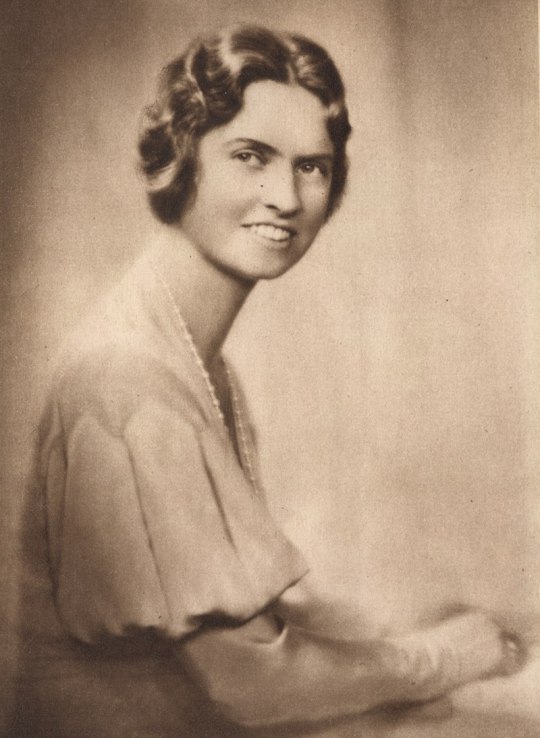
Princess Sibylla of Saxe-Coburg and Gotha (18 January 1908 – 28 November 1972) was a member of the Swedish royal family and the mother of the current King of Sweden, Carl XVI Gustaf.
Born into the House of Saxe-Coburg and Gotha, Sibylla was the daughter of Charles Edward, the last duke of Saxe-Coburg and Gotha. She became a Swedish princess when she married Prince Gustaf Adolf, Duke of Västerbotten in 1932. She thus had the prospect of one day becoming queen consort of Sweden, but the prince was killed in an airplane crash in 1947 and did not live to ascend the Swedish throne. Sibylla thus never became Crown Princess or Queen herself since her husband died before his father and his grandfather King Gustav V. Nor did she live to see her son become king of Sweden in 1973.
#Sibylla of Saxe-Coburg and Gotha#House Saxe-Coburg and Gotha#XX century#people#portrait#photo#photography#Black and White
3 notes
·
View notes
Text
Concert Scene Notes
I tried to post this privately so it didn't get in the way but technology is hard. These are my research notes for the concert scene of CMUL!
I did a lot of largely unnecessary research for this, and I wanted to share some of it just because I had such a fun time and some of it was so interesting.
First: here is a visual guide of where Wille spent his night.

And here is a visual of where Wille was poking his head out of while watching Simon sing.

I wanted to get a good visual for where Wille would be watching the concert from. When looking into the organ at Storkyrkan, I came across this video of Princess Estelle (the daughter of Crown Princess Victoria) visiting Storkyrkan to learn about the organ. It is SO sweet, and you get a couple of good shots at how large the space is that Wille is hiding in.
I wanted to take a second to reiterate the point that Edvin and the YR creative team keeps making about Wilhelm. Wilhelm's problem is not that Simon is a guy. Wilhelm's problem is that he is a prince.
Being face to face with SO MUCH symbolism of the monarchy when he was in a super vulnerable state was the cause of his anxiety. It wasn't really about Simon. Which is why Wille has such a hard time telling Simon what happened.
Okay, back to my days of googling.
I kind of lucked out when it came to the physical placement of all this. I initially picked Storkyrkan because I thought it was the closest church to the palace Wille lived in. Turns out that there are multiple royal palaces in Sweden and I was very wrong. However, it did feel right to have there be a royal palace that Wille would have to walk by in order to get to where he was supposed to meet Simon. Especially given that Kungliga slottet is more symbolic of the monarchy to Wilhelm and less like a home.
And then having the statue of King Gustav III right there? At first I was excited because it was a statue of a king in the perfect outdoor spot with a really nice visual of Simon waiting on those steps. The fact that it was a king I thought would be enough to definitely cause a bit of a royalty-related spiral in Wille’s mind. But THEN I ventured to Gustav’s wikipedia page.
“It was rumored at the time that Gustav was homosexual, a possibility asserted by some writers. The close personal relationships that he formed with two of his courtiers, Count Axel von Fersen and Baron Gustav Armfelt, were alluded to in that regard. His sister-in-law Charlotte implied as much in her famous diary.”
I MEAN???
His Wikipedia page is so interesting. Worth a read!
Also interesting is the Wikipedia for Storkyrkan, where I spent a ridiculous amount of time researching.
If I sat here and researched for another week I could have every inch of this thing dripping in symbolism. And I am writing this from an iPad in Boston, 3750 miles away. I’m sitting here falling more and more in love with Stockholm and I honestly wish I could go there just to research this one silly scene in person. Maybe someday. <3
I also wanted to link to the two full-length Storkyrkan concerts I watched in full to prepare for writing this. The first was Georg Friedrich Händels storverk Messias, and the second was On Stage Stockholm i Storkyrkan. Both helped me get a feel for what concerts looked and felt like in the space.
Uhhhhhh I might keep editing this post as the night goes on, I just want to post SOMETHING so I can get this posted before it gets to be too late.
8 notes
·
View notes
Text



90 years since HRH Princess Theodora of Greece and Denmark , Margravine of Baden Marriage 17–08–1931
Theodora was the second of five children of Prince Andrew of Greece and Princess Alice of Battenberg. She was born May 30, 1906 at Tatoi.
The little Princess, who was baptized according to the rites of the Greek Orthodox church, was given the nickname, Dolla, by her older sister, Margarita, who was born in April 1905. Margarita called her sister “dear Dolla,” as she could not pronounce Theodora.
Princess Theodora of Greece came to the attention of the international media in March 1928, when the New York Times and other newspapers reported that the 22-year-old princess was going to become engaged to Prince Gustaf Adolf of Sweden, the eldest son of Crown Prince Gustaf Adolf and his first wife, the British-born Princess Margaret of Connaught. The Crown Prince’s second wife, Louise, was Theodora’s aunt. Despite the family connections, the proposed engagement was nothing more than mere rumor.
Finding husbands for the pretty, but poor Greek princesses, was proving to be difficult.
Much to everyone’s surprise, 16-year-old Princess Sophie was the first of the four sisters to marry. In December 1930, she married Prince Christoph of Hesse, .
Two months later, Princess Cecilie married to Hereditary Prince Georg Donatus of Hesse. In April 1931, Margarita was wed to Gottfried, the 8th Prince of Hohenlohe-Langenburg.
Dolla was the only one of the four sisters to not marry a descendant of Victoria. On August 17, 1931, she was married to the Margrave of Baden. Prince Berthold had succeeded his father, Prince Max, the last Chancellor of Imperial Germany, in 1929.
Berthold was also born in 1906. He spoke English fluently, and studied at Oxford University.
The couple’s civil marriage took place on August 15, 1931 at the Neue Schloss in Baden-Baden.
Two days later, Dolla and Berthold were married in the schloss’ chapel. Two marriage ceremonies were performed: Lutheran and Greek Orthodox. Only “relatives and intimate friends” were present for the wedding, and the guests included Grand Duchess Hilda of Baden, Princess Marie of Baden, Queen Sophie of Greece, Crown Princess Louise of Sweden, Prince Waldemar of Denmark, the Duchess of Cumberland, the Duke of Brunswick-Lüneburg, the Grand Dukes and Grand Duchesses of Hesse and By Rhine and Mecklenburg.
Prince Andrew and Dolla’s three sisters were present, but Princess Alice, confined to a mental hospital, missed all four of her daughters’ weddings.
After the wedding, Crown Princess Louise wrote to a family friend: “I do hope Dolla will have a very happy life with Berthold because I think in some ways she expects more than her sisters.” Dolla was once described as the most “correct” of the four sisters.
Eleven months after the wedding, Dolla gave birth to a daughter, who was christened Margarita Alice Thyra Viktoria Marie Louise Scholastica. A son and heir, Maximilian Andreas Friedrich Gustav Ernst August Bernhard, was born in July 1933. A second son, Prince Ludwig Wilhelm Georg Ernst Christoph, was born in March 1937.
90 χρόνια από τους γαμους της ΑΒΥ Πριγκίπισσας Θεοδώρας της Ελλάδας και της Δανίας, Margravine of Baden στις 17–08–1931
Η Θεοδώρα ήταν το δεύτερο από τα πέντε παιδιά του πρίγκιπα Ανδρέα της Ελλάδας και της πριγκίπισσας Αλίκης του Μπάτενμπεργκ. Γεννήθηκε στις 30 Μαΐου 1906 στο Τατόι.
Η μικρή πριγκίπισσα, που βαφτίστηκε σύμφωνα με τις τελετές της ελληνορθόδοξης εκκλησίας, πήρε το παρατσούκλι, Dolla, από τη μεγαλύτερη αδελφή της, Μαργαρίτα, η οποία γεννήθηκε τον Απρίλιο του 1905. Η Μαργαρίτα αποκαλούσε την αδελφή της «αγαπητή Ντόλα», αφου δεν μπορούσε να προφέρει το Θεοδώρα.
Η πριγκίπισσα Θεοδώρα της Ελλάδας ήρθε στην προσοχή των διεθνών ΜΜΕ τον Μάρτιο του 1928, όταν οι New York Times και άλλες εφημερίδες ανέφεραν ότι η 22χρονη πριγκίπισσα επρόκειτο να αρραβωνιαστεί με τον πρίγκιπα Γουσταβο Αδόλφο της Σουηδίας, τον μεγαλύτερο γιο του πρίγκιπα Διαδόχου Γουσταβου Αδόλφου και
τής πρώτης του σύζυγου πριγκίπισσα Margaret of Connaught της Βρετανίας. Η δεύτερη σύζυγος του διάδοχου πρίγκιπα, η Λουίζα ήταν θεία της Θεοδώρας. (Αδελφή της μητερας της ΑΒΥ Πριγκιπισσας Αλικης της Ελλαδος )
Παρά τις οικογενειακές σχέσεις, ο προτεινόμενος αρραβώνας δεν ήταν παρά μια φήμη.
Η εύρεση συζύγων για τις όμορφες, αλλά φτωχές Ελληνίδες πριγκίπισσες, αποδείχτηκε δύσκολη.
Προς έκπληξη όλων, η 16χρονη πριγκίπισσα Σοφία ήταν η πρώτη από τις τέσσερις αδελφές που παντρεύτηκαν. Τον Δεκέμβριο του 1930, παντρεύτηκε τον πρίγκιπα Χριστοφορο της Έσσης.
Δύο μήνες αργότερα, η πριγκίπισσα Κεκιλια παντρεύτηκε τον πρίγκιπα Γεώργιο Ντόνατους της Έσσης.
Τον Απρίλιο του 1931, η Μαργαρίτα παντρεύτηκε τον Γκότφριντ, τον 8ο πρίγκιπα του Hohenlohe-Langenburg.
Η Ντόλα ήταν η μόνη από τις τέσσερις αδελφές που δεν παντρεύτηκε απόγονο της Βασιλισσας Βικτώριας της Αγγλίας. Στις 17 Αυγούστου 1931, παντρεύτηκε τον Margrave του Baden. Ο πρίγκιπας Μπέρτολντ διαδέχθηκε τον πατέρα του, τον πρίγκιπα Μαξ, τον τελευταίο Καγκελάριο της Αυτοκρατορικής Γερμανίας, το 1929.
Ο Μπέρτολντ γεννήθηκε επίσης το 1906. Μιλούσε άπταιστα αγγλικά και σπούδασε στο Πανεπιστήμιο της Οξφόρδης.
Ο πολιτικός γάμος του ζευγαριού πραγματοποιήθηκε στις 15 Αυγούστου 1931 στο Neue Schloss στο Μπάντεν-Μπάντεν,
Δύο μέρες αργότερα, η Ντόλα και ο Μπέρτολντ παντρεύτηκαν στο παρεκκλήσι του Neue Schloss. Πραγματοποιήθηκαν δύο τελετές γάμου: Λουθηρανικη και Ελληνορθόδοξης . Μόνο «συγγενείς και στενοί φίλοι» ήταν παρόντες στο γάμο και οι καλεσμένοι ήταν η μεγάλη δούκισσα Hilda του Baden, η πριγκίπισσα Marie του Baden, η βασίλισσα Σοφία της Ελλάδας, η πριγκίπισσα Λουίζα της Σουηδίας, ο πρίγκιπας Waldemar της Δανίας, η δούκισσα του Cumberland, ο Δούκας του Brunswick-Lüneburg, οι Μεγάλοι Δούκες και οι Μεγάλες Δούκισσες της Έσσης και του Ρήνου και του Μέκλενμπουργκ.
Οι τρεις αδελφές του πρίγκιπα Ανδρεα της Ελλ��δος και της Ντόλλα ήταν παρόντες, αλλά η μητέρα τους πριγκίπισσα Αλίκη της Ελλαδας κλεισμένη σε ψυχιατρείο, έχασε και τους τέσσερις γάμους των θυγατέρων της.
Μετά το γάμο, η πριγκίπισσα Λουίζα έγραψε σε έναν οικογενειακό φίλο: «Ελπίζω ότι η Ντόλα θα έχει μια πολύ ευτυχισμένη ζωή με τον Μπέρτολντ, γιατί νομίζω ότι κατά κάποιο τρόπο περιμένει περισσότερα από τις αδερφές της». Η Ντόλα είχε περιγραφεί κάποτε ως η πιο «σωστή» από τις τέσσερις αδελφές.
Έντεκα μήνες μετά το γάμο, η Dolla γέννησε μια κόρη, η οποία βαφτίστηκε Margarita Alice Thyra Viktoria Marie Louise Scholastica. Ένας γιος και κληρονόμος, ο Maximilian Andreas Friedrich Gustav Ernst August Bernhard, γεννήθηκε τον Ιούλιο του 1933. Ένας δεύτερος γιος, ο πρίγκιπας Ludwig Wilhelm Georg Ernst Christoph, γεννήθηκε τον Μάρτιο του 1937.
#kingconstantine#crownprincepavlos#greek royal family#queenannemarie#danishroyalfamily#house of romanov#princessmarieolympia#princess theodora#princeachileasandreas#princeconstantinealexios#princenikolaos#princesstatiana#crownprincessmariechantal
7 notes
·
View notes
Text
Eugène and his Bavarian family
This is the second part of the answer to the question by @mademoisellewhistler about Eugène's friends, this time dealing with Eugène's relatives by marriage, the royal family of Bavaria. Thank you once more for the Ask.
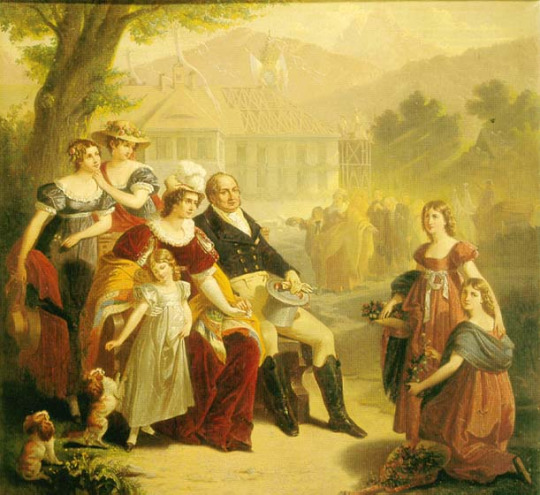
(Max Joseph, his second wife Karoline and their five daughters, painting from 1821)
***
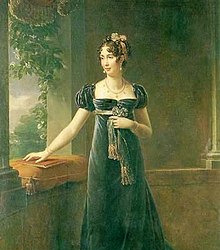
Let's start with his spouse, Auguste. In short, she adored him. After having yielded in tears to the raison d'état and sacrificed herself for the fatherland (her own words) at Christmas 1805, she apparently realised rather quickly that she had not made a bad bargain when she gave up her cousin Charles. At the end of May 1806, Eugène for the first time had to leave her for a few days, and she whined about it in letters to anyone who would listen, Napoleon included. (Napoleon must have been quite puzzled by this; things had been very different in his own marriage).
After all, who could have guessed that this totally unacceptable bridegroom would turn out to be such a nice guy?
Napoleon was otherwise not very successful as a marriage broker, but this marriage, which he had coerced, actually turned out to be very happy, and my impression is that he was immensely proud of it. However, he was to suffer as a result of this success, because Auguste soon felt that her Eugène was getting the short end of the stick compared to Napoleon's brothers and brothers-in-law. Napoleon charged him with most of the work, but the royal crowns and honours went to other people. From the time of his divorce from Josephine at the latest, she was not at all well disposed towards Napoleon. But that is another story. Even the loss of his position could not change her affection for Eugène. On the contrary, we have some of the most touching letters between them from this period.
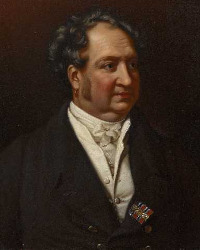
Next, Eugène’s father-in-law, King Max Joseph of Bavaria. In short, he adored him. If Auguste hadn't married Eugène, Max would probably have done it himself, just to keep this guy in the family. This was exactly the son he had always wanted, handsome, polite, cheerful, well-mannered, brave soldier and, above all, French! (And what had fate given him instead? Crown Prince Ludwig.) Eugène and Max Joseph were, in Auguste's opinion, very much alike in many ways; no wonder they got on well together. Max took a lively interest in all things concerning Eugène and Auguste; when Auguste finally gave birth to their long-awaited son in 1810, he wrote from Munich that he had not been able to sleep all night because of his excitement and happiness at the news. Normally I would consider this a rhetorical phrase; in Max's case it is probably to be understood literally.
The relationship between Eugène and Max Joseph seems, as far as can be deduced from the letters, to have been more family-like than that between Eugène and Napoleon. Towards Napoleon, Eugène always maintains a very submissive, respectful tone; Napoleon is always "Sire" and "Votre Majesté". But he addresses Max as "Mon bon père", my good father, and in his letters to Auguste he likes to speak of "notre père", our father, referring to Max.
I have already written about the negotiations that took place between the two of them in 1813/4, even though they belonged to opposing camps.
They also quarrelled - once, over Tyrol. Max Joseph did not agree at all with a proclamation that Eugène had published, and wrote to him about it. Whereupon Eugène wrote to his wife almost in despair, oh crap, crap, crap! Now I've quarrelled with your father over this thing, I hate this Tyrol!
(The disgruntlement did not last long.)
Eugène's early death hit Max Joseph hard. According to Planat de la Faye, he never afterwards referred to his son-in-law as anything other than "mon pauvre Eugène", my poor Eugène.
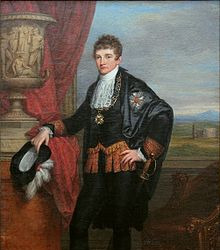
Crown Prince Ludwig. In short, he hated him. Or possibly not. Unless he did. In any case, he hated everything French and in particular everything connected with Napoleon, which at least at times certainly included his French brother-in-law. He got so upset about his sister's forced marriage to the unworthy Beauharnais that he wrote a play about the matter over the next few years (a tragedy, some of it being unintentionally funny if you know the actual story).
Of course, the guy, on the other hand, was very very nice. But that didn't change the fact that he was French. "Of all the Frenchmen, Eugène is probably still the best," Ludwig is supposed to have said. This was probably the greatest compliment Eugène could expect from his brother-in-law.
In part, Ludwig's dislike may have been jealousy. Ludwig and Max Joseph did not get on at all; Ludwig probably feared that Eugène would replace him with Max. Napoleon did not make matters any better when he occasionally pointed out that crown princes could also be shot for disobedience and that, after all, Eugène's children were also grandchildren of the Bavarian king.
On top of that, Max Joseph and Auguste had the idea that good-natured Eugène should speak to Ludwig's conscience from time to time about Ludwig’s attitude towards the French Emperor, his frequenting of dubious taverns and the good behaviour of crown princes in general. Eugène did it, as he did almost everything he was told, but it did not go down well at all with Ludwig.
When Eugène finally ended up in Bavaria after the fall of the Empire, the rivalry escalated to the point where Louis wanted to duel him (he was quick with duel demands - he knew full well that someone would always stop it). He prevented Eugène's children from becoming part of the royal family, and it almost came to the point that Eugène and his family would have left Bavaria again. In the end, Auguste wrote a bitterly blunt letter to her brother, and they came to an arrangement.
And, as I said, Eugène was a terribly nice guy. Besides, he had bought a small castle outside Munich, in Ismaning, at just the right distance from town to ride out there in the morning and then have breakfast with sister, brother-in-law and nieces and nephews ... which Ludwig, when he was in Munich, did regularly. Apparently his aversion to all things French did not extend to breakfast.
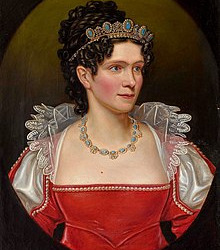
Queen Karoline of Bavaria, second wife to Max Joseph and stepmother to Auguste. Which I guess makes her Eugène’s stepmother-in-law? In short: Undecided. In theory, she couldn't stand Eugène. In theory, she never forgave him for stealing her little brother's bride. In theory, she was forbidden to like the guy if only because he was Napoleon's stepson and she didn't like Napoleon, being sister to the tsarina. But in practice it was always so hard to keep up that dislike once you met him, with him being so damn charming.
When Eugène came to Bavaria, relations were quite strained, especially between Auguste and Karoline. On the other hand, Eugène simply became part of the family. There are touching letters from Karoline about Eugène's death, in which she describes in detail to her mother how he was no longer able to speak at the end and took her hand and put it on his heart to say goodbye ... when reading this, one has the feeling that she was truely very touched and that she really had to get something off her chest.
By the way, there was a second source of conflict between Eugène and Karoline: Karoline's sister, Friederike, was the wife of ousted King Gustav of Sweden. And Eugène married his daughter to the son of the "usurper" Bernadotte. Karoline was not happy about this.
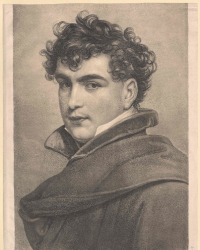
Auguste’s younger brother, Karl Theodor, called »Charles« in the family. He was still a child when Auguste left for Italy but seems to have liked Eugène from the beginning. In spring 1813, when Eugène was at the head of what was left of the Grande Armée, Karl Theodor wrote him an urgent letter and begged that Eugène would call him to the army as his ADC. Eugène, having his hands full with generals who turned blind and deaf with shock when orders came in, and soldiers who broke down in fear at the word "cossack", wrote back politely but firmly that now was a very bad time. Maybe later, when war resembled war again.
During his time in Bavaria, Karl Theodor was one of Eugène's friends in Munich, but he was only the second son, with future King Ludwig calling the shots. Eugène made him executor of his will.
How Auguste's younger sister Charlotte, the family's ugly duckling, viewed Eugène, I don't know, but she seems to have been more on Ludwig's side. Auguste's younger half-sisters, born of Max Joseph's marriage to Karoline, were close in age to Eugène's children, with whom they often played together. It is said of Ludwig's eldest son, the future King Maximilian II, that he always retained very positive memories of his French uncle, especially because Eugène was the exact opposite of the authoritarian, stubborn and stingy Ludwig.
And then there is somebody who was not officially part of the family, but factually: Auguste's old governess, Madame de Wurmb, called "Machère", whom Eugène had, so to speak, co-wed. "Machère" had substituted for Auguste's mother, deceased at an early age, and meant a great deal to her. Throughout her life, she kept a strict regime over her former pupil and, since she accompanied Auguste to Italy as a lady-in-waiting, also over Auguste's husband. Planat de la Faye, who met her in 1822, gives a rather amusing description of her. She had still been brought up in "Ancien Régime" Paris and lived entirely according to its principles (or what she regarded as its principles). When, after the end of the Empire, Eugène and Auguste travelled to Baden with very little luggage and entourage for financial reasons, and Eugène helped his wife into the carriage himself for want of a servant, the world came to an end for Madame de Wurmb ...
"Machère" probably never really forgave Eugène for daring, as a mere Beauharnais, to marry "her" princess. But she had to acknowledge that he made Auguste very happy, and that most of the time he really did behave as if he were a real prince (or what Machère regarded as one).
Eugène's biographer Adalbert of Bavaria suggests that Napoleon advised Eugène upon his marriage to first take the old governess to Italy and then throw her out as soon as possible. Which, of course, good-natured Eugène never did. There is a very funny anecdote about the first meeting between "Machère" and Napoleon, which Napoleon himself reported and which I will reproduce here soon anyway. In his letters to Auguste, Napoleon sent greetings to the lady every now and then - or maybe that was his way of finding out if the old dragon was still there and if it was already safe to visit Italy...
#eugene de beauharnais#napoleon#king max joseph#auguste von bayern#karoline von bayern#max joseph#eugene's marriage#ludwig i#bavaria#munich
13 notes
·
View notes
Text
GUSTAV III
King of Sweden
(born 1746 - died 1792)
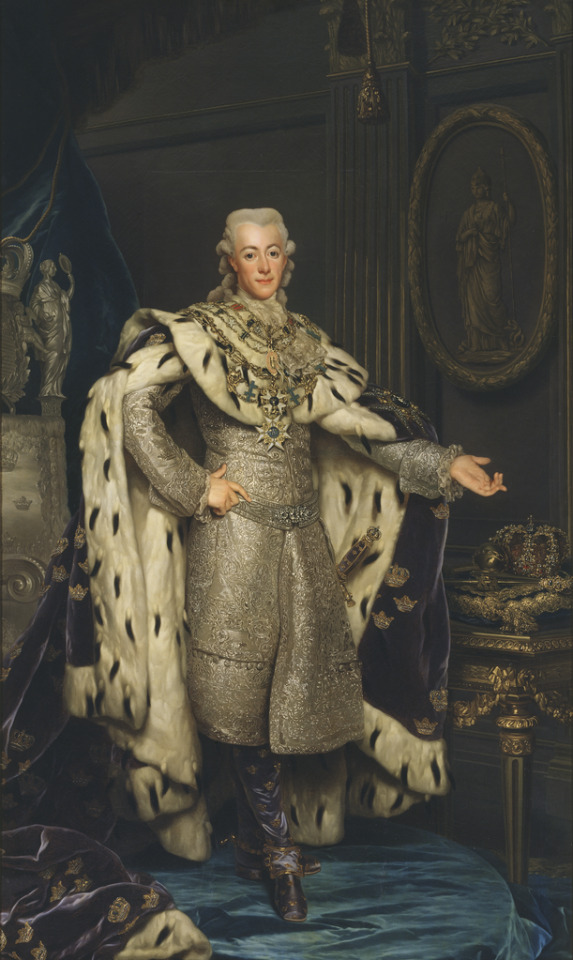
pictured above is a portrait of the King of Sweden, painted by Alexander Roslin in 1777
-------------------- ~ -------------------- ~ --------------------
GUSTAV was born in 1746, in Stockholm, as the second child of Adolf Friedrich of Holstein-Gottorp, Prince-Bishop of Lübeck and Princess Luise Ulrike of Prussia. He was born in Sweden because, since 1743, his father was the elected heir to the Swedish throne.
He was born a member of the main line of the HOUSE OF HOLSTEIN-GOTTORP and was from birth a PRINCE OF HOLSTEIN-GOTTORP.
His father acceded as Adolf Fredrik, King of Sweden, in 1751, officially founding the Swedish line of the House of Holstein-Gottorp. And he, at five years old, became the CROWN PRINCE OF SWEDEN.
In 1766, he married PRINCESS SOPHIE MAGDALENE OF DENMARK, the eldest daughter of Frederik V, King of Denmark, and Princess Louisa of Great Britain. He and his new wife were the same age, having married at the age of 20. With her, he had two sons.
Check a list of his children at the end of this post!
A month after his 25th birthday in 1771, his father died, and he succeeded as GUSTAV III, KING OF SWEDEN. At that time, the Swedish Parliament (called Riksdag) held more power than the Monarch.
So, by 1772, he rebelled in the Revolution of 1772. And, through his blodless coup d'état he had a new Constitution approved, the Instrument of Government of 1772.
Through this new constitution, he, as the Monarch, received the power to assemble Parliament only by his own wishes. But he was determined to rule without them.
But, as Parliament still retained power to approve taxes and wars, in 1789, he assembled them to get money to the Russo-Swedish War.
This Parliament only lasted for over three months. Though he was successful in approving a new amendment to the Constitution, known as the Union and Security Act.
The act declared that he, the Monarch, could choose his own Privy Council and also gave him the power over war decisions without having to ask Parliament. It abolished some privileges of the nobility, such as their sole right to own lands or hold high positions in the government. Parliament lost the rights to create new laws but was left with power over taxes.
Not content with his government, by late 1791, the nobility started to plan his assassination.
On 16 March 1792, he went to a masquerade ball at the Gustavianska Opera House in Stockholm. That night, he received a letter warning of a plot to assassinate him, and it is said that he showed up at an open balcony to prove himself fearless.
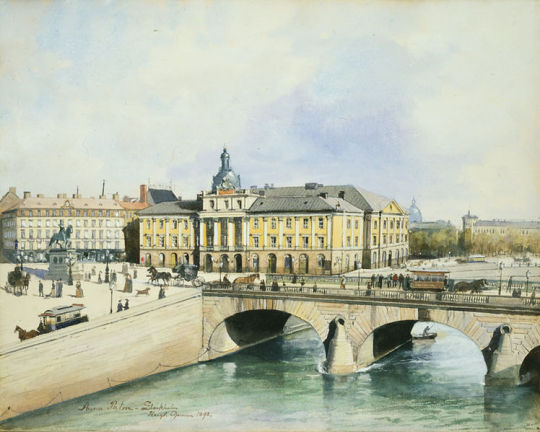
pictured above is the Gustavianska Opera House, painted by Anna Palm de Rosa in 1892, before the building was demolished
Later that the night, a former military officer Jacob Johan Anckarström took advantage of the masquerade crowd and shot fire on him. But, as it was not a mortal shot, he continued to rule for a couple of days.
However, on 29 March 1792, the King of Sweden succumbed to sepsis at Stockholm Palace, at the age of 46.
-------------------- ~ -------------------- ~ --------------------
On his death, his only surviving son, the 13-year-old, Crown Prince Gustav Adolf, succeeded to the Swedish throne as King Gustav IV.
It was also also a turbulent reign as his son was deposed in 1809 by the same Parliament he had endlessly fought, that ended with his descendants being forever excluded from the Swedish line of succession.
-------------------- ~ -------------------- ~ --------------------
GUSTAV and his wife SOPHIE MAGDALENE had two children.
Gustav IV Adolf, King of Sweden - husband of Princess Friederike of Baden; and
Karl Gustav, Duke of Småland - died at age six months.
-------------------- ~ -------------------- ~ --------------------
SERIES - Facts & Events mentioned in previous posts (F&E):
The assassination of Gustav III, King of Sweden, was mentioned in my post on the life of his son, Gustav IV Adolf, King of Sweden.
#gustav iii#gustav iii of sweden#king gustav iii#king of sweden#house of holstein gottorp#holstein gottorp#swedish royals#swedish royal family#royals#royalty#monarchy#monarchies#royal history#swedish history#european history#world history#history#history lover#regicide#18th century#king adolf frederick#history with laura#F&E
5 notes
·
View notes
Text


Sophie, Dowager Grand Duchess of Baden (1801-1865) in 1864.
Sophie was born in Stockholm, Sweden, on 21 May 1801. She was the daughter of King Gustav IV Adolf of Sweden and his wife, Princess Frederica of Baden. After her birth, she was raised under the supervision of the royal governesses Hedvig Ulrika De la Gardie and Charlotte Stierneld in succession.
Sophie was eight years old when her father was deposed by the Coup of 1809 and she left Sweden with her family. Between the time of the coup which deposed her father, and leaving Sweden, she and her mother were under house arrest. During this period, she was described in the famous diary of Hedwig Elizabeth Charlotte of Holstein-Gottorp as a stubborn girl who was much more haughty and possessed less self-control than her brother Gustav. An anecdote describes the contrast between the siblings. When Fredrika and her children were given permission to join the deposed king, famous Swedish nobleman Axel von Fersen came to discuss the arrangements. When he was about to leave, Sophie's older brother ran to the door to open it for Fersen. The former queen Fredrika is quoted as saying, "Sophie would never in the world have done that, she thinks of herself too highly for that."
In 1815, she was engaged, and on 25 July 1819 in Karlsruhe, Sophie married her half-grand-uncle Prince Leopold of Baden, the son of a morganatic marriage. The marriage with Leopold had been specifically arranged by her uncle, Grand Duke Karl I of Baden, to improve the chances that Leopold would one day succeed him as grand duke because of Sophie's royal lineage; Leopold, though his right to the throne was recognized, was originally the issue of a morganatic marriage. During the reign of Louis I, Grand Duke of Baden, they lived a modest life away from court, as Louis did not want the heir to the throne at court. In 1830, her husband ascended to the grand ducal throne as Leopold I, and Sophie became Grand Duchess of Baden.
Sophie is described as wise and dutiful but strict. She kept late hours and arose late in the mornings, after which she spent hours writing letters to various relatives around Europe in her négligée. She was interested in science, art and politics, and kept herself well informed on all political events of the day through her correspondence. Her ties to the Viennese court were particularly tight, and it was to Vienna her sons were sent to complete their education. Sophie retained a certain bitterness over the deposition of her father, and took it very badly when her brother was deprived of his status as a Swedish prince.
During the tumult caused by the appearance of Kaspar Hauser, Sophie was rumoured to have ordered Hauser's assassination in 1833. This damaged her relationship to her husband, and Sophie was said to have had an affair. During the revolution of 1848, she was forced to flee from Karlsruhe with her family to Strasbourg. They returned in 1849, after the revolt had been subdued by Prussian forces. She became a widow in 1852. Sophie convinced her son Frederick to enter an arranged dynastic marriage rather than a marriage to his love, Baroness Stephanie von Gensau.
In 1852, the Swedish royal house wished to make peace with the deposed Swedish royal house, and Oscar I of Sweden and Josephine of Leuchtenberg tried to arrange a meeting, but without success. In 1863, however, Sophie met the Swedish heir presumptive Prince Oscar II of Sweden and his consort Sophie of Nassau. The meeting was a success: Sophie asked him about how the Stockholm of her childhood had changed, and when they left, she presented the couple with a gift to their son prince Gustaf, a medallion with the inscription "G" and the crown of the Swedish Crown Prince, because he had the same name as her brother.
Family Resemblance

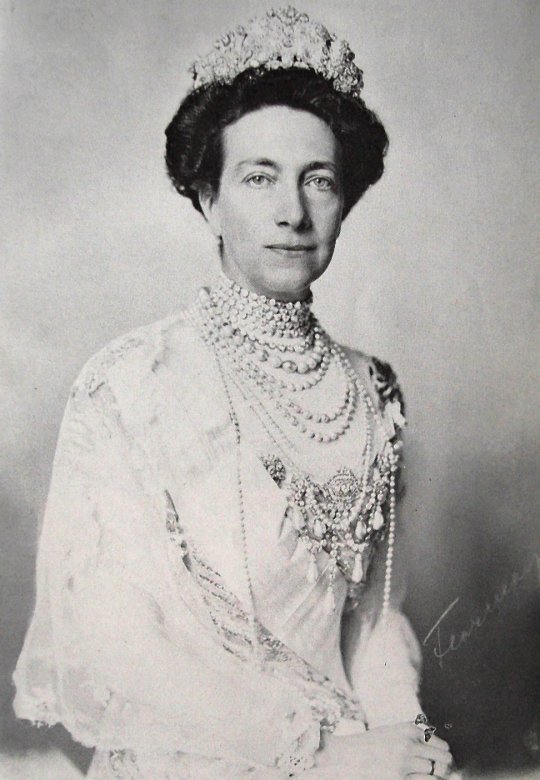
Her granddaughter, Queen Victoria of Sweden née Baden took after her.
Source: Royal Collection
#Grand Duchess sophie of baden#Dowager Grand Duchess sophie of baden#princess Sophie of Sweden#baden#queen victoria of sweden#princess Victoria of baden#german royal#german royalty#swedish royalty#swedish royal#1864#1860s
22 notes
·
View notes
Photo

Norway’s Tiaras: Queen Josephine’s Diamond Tiara (4/16)
This tiara, a personal favorite of mine, is a relic that shows the close familial relationships between the Scandinavian monarchies. A tiara of unknown provenance made of gold, silver, and diamonds, this tiara was first seen on the head of Queen Josephine of Sweden, the consort of Oscar I. While some believe this tiara originally belonged to Josephine’s predecessor Queen Désirée, most agree that Josephine was the first person to actually wear the tiara. Josephine wore it frequently, and after her death it was inherited by her granddaughter Princess Louise, who became queen of Denmark. After Louise’s death the tiara was passed to her son, Prince Gustav. Because he never married and had no children, Gustav chose to bequeath the tiara to his niece Märtha, the Crown Princess of Norway.
When Märtha died in 1954 her younger daughter, Princess Astrid, wore the tiara while she served as first lady of Norway. After Sonja Haraldsen became Crown Princess of Norway in 1968, the tiara was passed to her. She has been the only lady to wear it since, cementing it as one of two tiaras designated for the first lady of the land. While Sonja has worn it for important occasions such as her daughter’s wedding, it isn’t seen as often as some the other tiaras in her collection. Perhaps Crown Princess Mette-Marit or Princess Ingrid Alexandra will give it more love when it passes into their hands.
#queen sonja#crown princess martha#queen josephine#princess astrid mrs ferner#Norwegian Royal Family#swedish royal family#danish royal family#norway's tiaras#tiaras#tiara#***mine
35 notes
·
View notes
Photo

Margaret of Connaught, Crown Princess of Sweden (15 January 1882 - 1 May 1920)
#margaret victoria charlotte augusta norah#margaret of connaught#crown princess of sweden#daughter of prince arthur duke of connaught and strathearn#wife of gustav vi adolf of sweden#history#women in history
5 notes
·
View notes